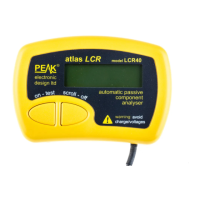Testing Capacitors
The Atlas LCR uses two different methods to analyse
capacitors, AC impedance analysis for low value capacitors
(less than about 1μF) and DC charge analysis for larger
capacitors (about 1μF to 10,000μF).
Capacitors (particularly electrolytics) can store enough charge that
may cause damage to the LCR.
An electrolytic capacitor can even develop it’s own stored charge that
may be sufficient to cause damage to the Atlas LCR even after it has
been temporarily discharged. This is a characteristic known as
“Soakage”.
It is vitally important that you ensure the capacitor is fully discharged
(ideally for several seconds) to minimise the possibility of damage to the
unit.
If you are unsure, measure the voltage across the capacitor using a
suitable volt meter before applying the capacitor to the Atlas LCR.
The unit will automatically identify the type of capacitor being tested and
apply the most appropriate test method.
The capacitance will always be displayed in the most suitable units. To
convert between the various units refer to the following table:

